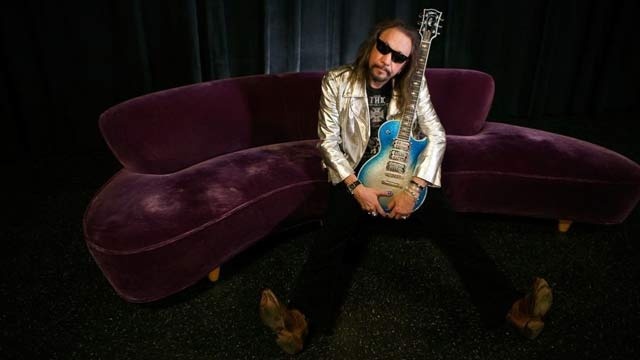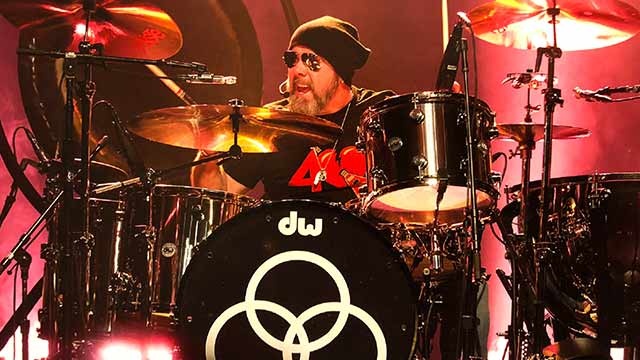The album is divided into two parts. The first contains a suite of songs for accordion in the seven Greek scales. Each one is meant to evoke different aspects of nature, and they all invite us to listen to and appreciate the accordion in a new and exciting way. In the second half, Conlee switches to piano and works with ostinatos (repeated melodic phrases) for five magical pieces, meant to hypnotize and inspire.
During our conversation, Conlee explained that because Covid restrictions made working with a band nearly impossible, the creative process for the accordion pieces was quite unique. “I applied for an artist’s residency. There’s this really funky vintage trailer park called the “Sou’Wester” on the coast here in Washington. And it’s like thirty vintage trailers… very arty. They have a little music venue…a little art gallery. So about thirty artists get together for a week and they put you up and then you do a proposal and at the end of the week you do a performance” she told me. The piano pieces, on the other hand, were written over the past three years. Conlee described her habit of gathering little “song seeds” in her everyday life. “With the piano ones, I just sort of collect. I’m always just sort of writing little piano things.”
Part of what makes these twelve songs so special is how much creative freedom and control Conlee had with the project. Unlike her work with bands or her last solo album French Kayaking Music (the soundtrack to the film Voyagers Without Trace), the stories Conlee told were completely up to her. “Because of the nature of the timing when I wrote these with Covid, I wanted to do something on my own, and that was the time to do it. It was unclear whether we were going to be able to get back together again and make music. So I think the biggest difference is that it’s all me and I’ll be performing it and recording it… the only guide is me. There’s no film I have to follow… it’s like just look at the hawk, what would the hawk say? And then how would you interpret that?”
Conlee also spoke a little on certain challenges that arose through being so independent. “It was all just one take so I had to get through the whole song, and that… that’s hard. And also the music is technically harder on this record so that’s something you have to think about sometimes. Like be careful what you do to yourself.” In addition, she said that these pieces “were more nebulous. I think it’s harder to just grab ideas out of the universe, thus why I give myself constraints such as modes or subject matter.”
Within these self-imposed confinements, however, Conlee found the opportunity to explore her musical inclinations and find a deeper sense of self. “I think there is more me [in the album]. I let my tendencies fly. I was just like ‘here’s my idea! Let’s keep it!’ ” For example, when writing the piano songs, she noticed that she’s drawn towards ostinatos in the bass. “I realized how much I’m doing that and that’s why I ended up calling them Five Ostinatos.” The effect of this is a very cohesive record. “The songs all live in one house. They all have similar energy and melodic content.”
This is not to say in any way, however, that the pieces don’t stand on their own. Conlee is a masterful storyteller, even without words. “Looking Glass”, the fourth piano piece on the album, especially stood out to me. In the beginning, her melodies are dreamy, legato, and light, sweeping you into a calm before crashing into harsh dissonance and eerie remnants of the initial sounds. We eventually return to the original phrase, but it has changed slightly. It clashes more frequently, and is no longer reminiscent of a dream.
When I asked her about the song, her explanation matched exactly with the story the music told. “I was hired to compose that piece by a group called “Twist Out Cancer” which pairs musicians with people dealing with cancer and then you try to tell their story. I was the first musician they used for that process because I’ve had cancer in my past so they brought me in.” Conlee was paired with a young woman who detailed her journey with cancer to Conlee. “[This woman’s] life was kind of cruising along until the announcement of her cancer which is the kind of crunching sound. It’s like this kind of dreamy kind of ‘oh here I am in life’, and then you hear the darkness of the diagnosis… And then she realizes (because [she and her husband] were trying to have a child) that, oh, she can have a child; that’s the big wide open area that gets back to the first theme again which is back to life. But it’s a little bit darker now, kind of like there’s this new edge to it. So I try to kind of follow those life events of hers in that piece.”
Her storytelling abilities are also found in the accordion pieces. “Hawk (Dorian)” soars and dives, evoking images of the powerful bird on the hunt, “Sunset (Ionian)” builds and expands with glorious color, and “Ocean (Mixolydian)” moves in waves, climbing and receding, and mimicking the seas unpredictable temperament.
When I asked Conlee if she went into the residency knowing which aspects of nature she would pair with which modes, she said that she just let herself be inspired by the world around her, except for two songs; “Sand (Aeolian) and “Wind (Phrygian).” “The one that really made me feel like I must do this was “Sand”, with the super high notes, on aeolian. That mode seems so otherworldly to me, so that seemed like the right thing.”
In order to explain her inspiration for “Wind”, words were insufficient. Instead, in a magical moment, Conlee’s accordion appeared out of nowhere. Lifting the massive instrument onto her lap with relative ease, she began to play me the phrygian mode that inspired the creation of her wind song. “The phrygian mode is just so exotic to me because of this part”, she explains as she plays. “I was like I must make that [mode] the wind song because it has that like… [she plays the scale]… I mean I guess what I’m doing is imagining it has a whirling dervish something, or some kind of a desert genie or something.”
The accordion made several other appearances as she spoke about her songwriting process. “To be honest I sometimes start my accordion music on piano because it’s a little easier to see what’s going on. Then the danger of that is that maybe it will be too hard for the accordion. [Piano and accordion] both do their own things well, but a c to a c sharp is really easy on the piano whereas a c to a c sharp on the accordion is the furthest jump you can make because of the way it’s set up. So yeah you need to be careful of those things.”
We finished our conversation by discussing what’s next for Conlee. First, she is looking forward to her upcoming shows, especially her March 26th show in Portland, Oregon, at The Old Church and her show at The Royal Room in Seattle, Washington, on April 30th because they both have beautiful grand pianos. “Like I just played these pieces in Eugene at a performing arts center, but they didn’t have a piano so I used my keyboard and it’s just not the same”, she explained. “I’m looking forward to those shows, and the other ones too, but I look forward to those because [they’re] super pro rooms with great sound engineers. It’s really important to have the sound be good because it’s not a rock show, it’s a listening show, so it’s nice to have an environment where it’s a sit-down quiet type of space.”
Once her solo stuff is over, Conlee hopes to write for her band The Jenny Conlee Quartet. The group is composed of piano, clarinet, accordion, drums and bass, but has yet to release a record. “I want to do a record for the band next time because I want to do more band shows, and so I think I need to write music for the band in order for the band to like have a song to play, you know? … Because I really enjoy performing with a band because solo performance is so stressful” she said with a laugh. “I like to share the pressure with everyone on stage.”
And in good news for The Decemberists fans (like myself), Conlee confirms new music is coming soon. “We [The Decemberists] did a tour last summer, just a quickie august tour, and we just started recording in the studio last month for a week and we’re just starting our new record. So I’m not sure when that will get done, we’re definitely not close to being done, but there’s definitely new songs in the works, so that’s exciting.”
In the meantime, don’t be scared to work some accordion music into your rotation! Jenny Conlee is a singular talent who approaches accordion music in an powerful, original, and innovative way. You can stream “Hawk (Dorian)” now, and be sure to look out for the complete Tides: Pieces for Accordion and Piano on March 24th. You can also catch Conlee touring on:
March 26th – The Old Church, Portland, OR
April 20th – Charlene Larson Center for the Performing Arts, Astoria, OR (w/ Casey Neill)
April 22nd – Brewvana, Prosser, WA (w/ Casey Neill)
April 30th – The Royal Room, Seattle, WA (w/ Casey Neill)
Aug. 19-20 – The Cotati Accordion Festival, Cotati, CA



